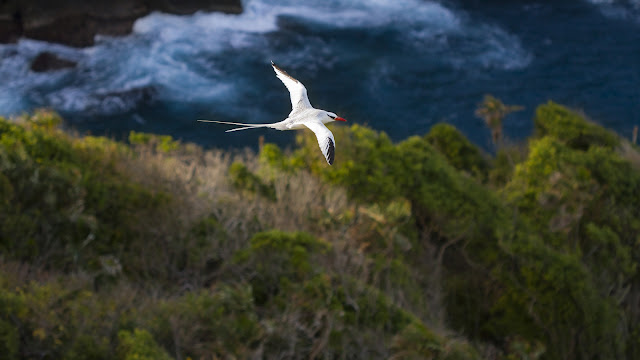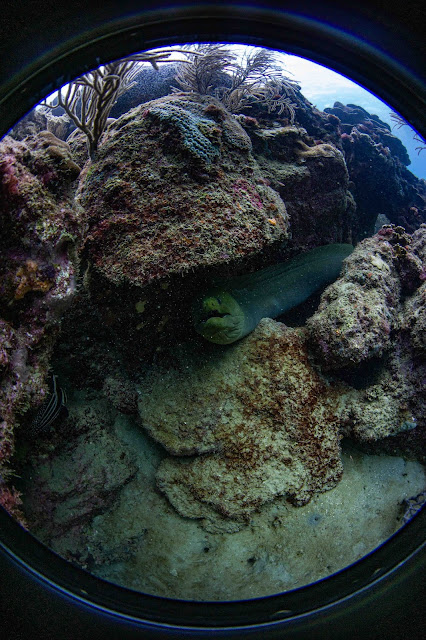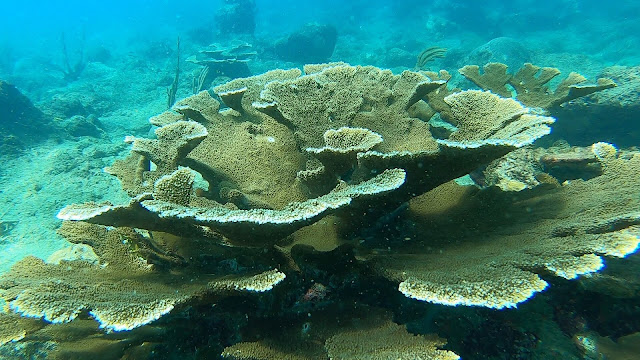Advocate for an Underwater Education
When I was about 14, at Signal Hill, my biology teacher brought a fisherman to tell us about sharks. He said that in order to stay alive, sharks had to swim continuously, something about their gill slits. This idea of constant motion intrigued me. In those days, the early 80s, there was one (scuba) dive shop, a club really, on the road to Pigeon Point. Dive Tobago was run by Jimmy Young. I started hanging around there after school. After almost a year of sweeping the shop, cleaning the boat, scraping the hull, generally doing whatever I was asked, I went on my first dive. And the first shark I saw was resting on the bottom, asleep. I proved the fisherman wrong for myself. When I was not in school, I was diving. At 17, I qualified as a dive master.
By the time I was 18, I went to the Coast Guard in Trinidad as diving instructor. I dived every chance I got. On the weekend, or my days off, dive operators in Tobago would ask me to mind their business when they went on vacation.
After 13 years in the Coast Guard, in 2001, I set up my own shop in Tobago, Frontier Divers. I have dived all around Tobago.
 |
| The Tobago Lionfish Hunters is a group of young people that Dougie has taught to scuba dive. All photos courtesy Alvin Douglas. |
Tobago is uniquely located at the point where the outflow from South American rivers, the Orinoco and the Amazon, feeds our reefs with rich river nutrients. From Crown Point, on the Atlantic side you’ll find a dozen dive sites; and on the Caribbean side, you’ll find a dozen more. The average visitor spending a week or two to dive in Tobago will have choices every day. On average, Tobago’s coastal waters are between 30 and 60 feet deep. One of my favourite dive sites, the Kariwak reef, is right there off Store Bay: you can walk in from the beach; we go there for training dives.
I’ve done and continue to do PADI certified training; for students and visitors, for the Coast Guard (based in Trinidad) and with the Tobago Emergency Management Authority. We train all the rescue divers. It would be a boost for education in Tobago if we could train in schools.
 |
Old anchor on Flying Reef at southern end of Tobago. |
 |
| Moray eels are reef dwellers. |
THE FUTURE OF TOBAGO
There’s an outdated policy in the Education department about not taking children in or around water, that needs to be changed; with precautions yes, but not a blanket ban. Tobago is a marine society; all our communities are built on the coast. The sea is recreation and education, it is life; it’s what visitors come here for. When you introduce children to the marine environment in the right way, they are very excited. Youngsters, say 9 to 13, would be easy to teach, before they are distracted by devices. They are the ones who need to love and protect the environment. Diving opens up science, history and archaeology to our children; gives them confidence and teaches responsibility for themselves.
I have a group of youngsters called the Tobago Lionfish Hunters. We connect through Whats App and meet once a month, to hunt out the invasive lionfish that prey on our reefs. But there’s a lot more that we could do. Diving is a life skill that island people need.
 |
| Alvin Douglas shows a conch. The green tint in the water is from high chlorophyll content in the outflow from South American rivers. |
SAFETY AND SECURITY IN OUR MARINE ENVIRONMENT
I’ve just registered another company, Tobago Marine Safety and Security Services, with a mandate to protect the Tobago marine environment and provide emergency services around the coast. It is very important for Tobago to be able to provide an immediate response in Tobago waters if needed; not have to wait for the Coast Guard to come from Trinidad. This presence, visibility and rescue capability gives visitors a sense of security; and provides jobs in communities around the coast.
We need this group to also ensure that visitors who come into our waters on their own boats, respect the Tobago environment: ensure that they are equipped to not flush toilets directly into our bays for instance; or drop anchor on reefs. We must be the watchdogs of our marine interests.
CORAL FEATURES AND SCULPTURE GARDEN
We have seen a lot of changes in the ocean over the past three decades. There are changes and there are cycles. For instance, we have seen mantas in Store Bay; they stayed three weeks this year. Hammerhead sharks used to school at Sisters islands, but we don’t see them there any more. There were always a lot of sea eggs (black spiny urchins) at No Man’s Land; then they disappeared; now, it seems they are coming back. Kariwak reef off Store Bay is still beautiful though severely damaged by rough seas and run off from the land. In every bleaching event, we’ve seen corals changing, and we’ve also seen them coming back.
We are consulting with the Cropper Foundation for the positioning of the Minshall designed sculpture garden. Remember we sank the Scarlet Ibis ferry (now called the Maverick divesite) off Mount Irvine (1997), and that is now one of the most interesting sites for the diversity of corals and fish species. We expect that this could happen with the sculptures, but they need to be in a place that is not too far for the glass-bottomed boat tours: maybe somewhere between Store Bay and Mount Irvine.
This year, we’ve had a very small high season; we’ve probably been busy for three weeks of the months between November to March. Only my return clientele is keeping the business alive.
So we added glassbottom kayak tours into No Man’s Land and through the mangrove. It is an educational tour in which visitors are told about the different types of mangrove, and why they are important.
I know Sandals is a desperate attempt to jumpstart the tourism industry, with their marketing machinery. But we need to ask ourselves what are we willing to give up to bring people to our shores. We need to know the environmental impact, and to estimate whether we can bear this cost. On the other hand, there is a pressing need to deal directly with the problems of transportation between the two islands.
 |
| Frontier Divers has expanded its business and now offers glassbottom kayak tours |
WHY DIVE?
All of us need to appreciate life on our planet. The ocean is 70% of our planet. In ten minutes underwater, you’ll see more life than you would in a rainforest.
Who could not enjoy being weightless, stimulated by colour and creatures and movement, with no distractions (no phones, tablets, media) for an hour at a time?
The educational value for everyone who ventures underwater is immense: not just biology but the history of our island. There are artifacts off Mt Irvine and ships at the bottom of Scarborough Harbour.
Scuba diving opens tremendous career possibilities: marine science, tour guides, environmental science and management, underwater welding, medicine and industrial applications. A boat captain or rescue diver earns more than a taxi driver or security guard.
It is possible that the ocean holds the future for at least half of our children growing up on Tobago. And it is a future that is available to them right here, today: all their training can be done in our waters. They all learn the same protocols, earn the same internationally accepted certification. No matter where in the world they go, they can make themselves at home and understood underwater, for the rest of their lives. (Pat Ganase)
 |
| Brain coral at Kelleston Deep, Speyside. This photo was taken three years ago. |
 |
| Alvin Douglas and Frontier Divers can be found at Store Bay. |


